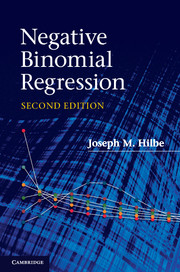Book contents
- Frontmatter
- Contents
- Preface to the second edition
- 1 Introduction
- 2 The concept of risk
- 3 Overview of count response models
- 4 Methods of estimation
- 5 Assessment of count models
- 6 Poisson regression
- 7 Overdispersion
- 8 Negative binomial regression
- 9 Negative binomial regression: modeling
- 10 Alternative variance parameterizations
- 11 Problems with zero counts
- 12 Censored and truncated count models
- 13 Handling endogeneity and latent class models
- 14 Count panel models
- 15 Bayesian negative binomial models
- Appendix A Constructing and interpreting interaction terms
- Appendix B Data sets, commands, functions
- References and further reading
- Index
2 - The concept of risk
Published online by Cambridge University Press: 05 June 2012
- Frontmatter
- Contents
- Preface to the second edition
- 1 Introduction
- 2 The concept of risk
- 3 Overview of count response models
- 4 Methods of estimation
- 5 Assessment of count models
- 6 Poisson regression
- 7 Overdispersion
- 8 Negative binomial regression
- 9 Negative binomial regression: modeling
- 10 Alternative variance parameterizations
- 11 Problems with zero counts
- 12 Censored and truncated count models
- 13 Handling endogeneity and latent class models
- 14 Count panel models
- 15 Bayesian negative binomial models
- Appendix A Constructing and interpreting interaction terms
- Appendix B Data sets, commands, functions
- References and further reading
- Index
Summary
Risk and 2×2 tables
The notion of risk lays at the foundation of the modeling of counts. In this chapter we discuss the technical meaning of risk and risk ratio, and how to interpret the estimated incidence rate ratios that are displayed in the model output of Poisson and negative binomial regression. In the process, we also discuss the associated relationship of risk difference as well as odds and odds ratios, which are generally understood with respect to logistic regression models.
Risk is an exposure to the chance or probability of some outcome, typically thought of as a loss or injury. In epidemiology, risk refers to the probability of a person or group becoming diseased given some set of attributes or characteristics. In more general terms, the risk that an individual with a specified condition will experience a given outcome is the probability that the individual actually experiences the outcome. It is the proportion of individuals with the risk factor who experience the outcome. In epidemiological terms, risk is therefore a measure of the probability of the incidence of disease. The attribute or condition upon which the risk is measured is termed a risk factor, or exposure.
Information
- Type
- Chapter
- Information
- Negative Binomial Regression , pp. 15 - 29Publisher: Cambridge University PressPrint publication year: 2011
